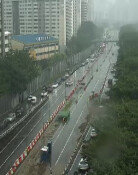Big Hospitals on Brink of Bankruptcy
Big Hospitals on Brink of Bankruptcy
Posted October. 20, 2002 22:45,
After the new medical system for separation of pharmacy and clinic took effect, more patients have showed tendency to visit neighborhood clinics or large-sized general hospitals. As a result, many middle-sized hospitals, the second medical institutions, are suffering financial difficulties. Among those even some large hospitals fail to pay a bill or make an announcement to shut down, signaling a red light to the medical community.
The problem is all the more severe because the second medical institutions are quagmired in a vicious cycle, in which many doctors are leaving those hospitals for the reason of low pays and those hospitals cannot make facility investments decisively.
Ñ Financial difficulties in the second medical institutions = The Korean Hospital Association (KHA) reported on Oct. 20 that because of rising labor cost and careless management, St. Francisco hospital in Guui-dong, Seoul, failed to pay a bill in late June. Also, Mokpo Catholic hospital (the second medical institution), which was famous as being the largest hospital in the Mokpo region, was said to have closed its business in mid-September, due to financial difficulties and labor dispute.
The KHA insisted, In 1999, before the separation of pharmacy and clinic started, the bankruptcy rate was only 6.5 percent, but the figure is expected to rise to 10.3 percent this year. If the government leaves the matter as it is, medical institutions cannot but wage large-scale protests to protect the right to live.
Ñ Point at issue = An official at St. Francisco hospital related, As the number of patients dropped, the hospital made facility investments such as construction of a second wing, but it was out of its power. Moreover, famous doctors quit and patients followed them. Finally, the hospital went bankrupt.
The number of doctors in the hospital, which was as high as 70 at its highest decreased to 50 just before the bankruptcy as doctors chose to practice medicine by themselves after the implementation of the new system. Due to a sharp drop in patients, the hospital reduced the internal department, which consisted of 4 units before to one unit, and the 5- unit pediatrics department to 3 units. However, it failed to keep it afloat again.
Payroll costs for doctors are on the rise, due to lack of them. A hospital official said, The monthly pay for the chief doctor of the internal department rose to 10 million won from 6 million won and bonus is added to on the performance basis. Even if hospitals increase pays by 100-300 percent, it is very difficult to find a doctor.
The fact that medical fees of health insurance are higher than in neighborhood clinics is also one of the contributors to the financial difficulties of the second medical institutions. In the cases of medical fees lower than 15,000 won, neighborhood clinics charge outpatients 3,000 won, based on a fixed sum system, while medium-sized hospitals should charge 40 percent of the original medical fees. It is not so much lower than the fee charged by large-scale hospitals (50 %), so it is loosing its price competitiveness.
Against this backdrop, more and more doctors try to open a clinic. According to the Korea Institute for Health and Social Affairs, the number of neighborhood clinics, the first medical institution, rose to 21,834 in March, up 21.3 % from last year. This growth is much higher than the last decades growth rate of 6-8 %. The increase in small clinics is also accelerating the exodus of doctors from the second medical institutions. According to the Ministry of Health and Welfare, one clinics heath insurance income excluding drug fees increased from 92.84 million won before the start of the new medical system (in the first half of 2000) to 137.38 million won after the new system went into effect (in the first half of 2001). This is a 48 % increase.
In the third medical institutions including university hospitals, outpatients should still wait to receive medical treatment for 2-3 months.
sys1201@donga.com stein33@donga.com




![정성국, ‘안철수 사퇴’에 “혁신위? 감독 임명해놓고 코치 못쓰게 하면…”[황형준의 법정모독]](https://dimg.donga.com/c/138/175/90/1/wps/NEWS/IMAGE/2025/07/08/131963488.1.jpg)


